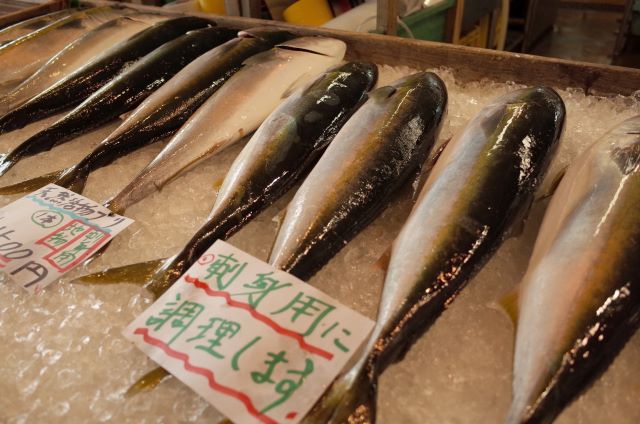
Fish is not only cooked and eaten as grilled or boiled fish but also eaten raw as sushi or sashimi. Naturally, the way to eat fish depends on individual tastes. But in fact, the way we eat fish depends on the time frame after we catch it.
Fish that is still alive or freshly dead is ideal for sashimi. In this case, you should enjoy the elasticity of the flesh, or texture, rather than the umami of the fish. Only the freshest fish is suitable for sashimi. The fish will go rigor mortis within a few hours at the earliest, and within a few days at the latest. The period leading up to rigor mortis is the time when the umami component increases, making it ideal for sushi.
On the other hand, the flesh becomes softer, so it is the sushi chef’s job to find the right balance between the umami and the chewiness of the fish. Of course, for those who prefer fish with more umami, it can also be served as sashimi. The rigor mortis of the fish is eventually dissipated and it gradually begins to decompose, so it is consumed as sashimi or sushi until a certain point in time.
The chef’s job is to determine when the fish cannot be used as sashimi or sushi. After that, the fish will be consumed as grilled or boiled fish. Eventually, the color, taste, and aroma of the fish will change dramatically, and it will reach the so-called putrefied state, making it inedible. The chef’s job is to determine when the fish cannot be used as sashimi or sushi. After that, the fish will be consumed as grilled or boiled fish. Then the color, taste, and aroma change dramatically, and the fish reaches the so-called putrefied state and becomes inedible.
A variety of conditions exist before rigor mortis sets in. Ideally, the fish should be properly processed and cooled as soon as possible after it is caught. Without this, rigor mortis will set in immediately, shortening the time until the rigor mortis is dissipated and speeding up the decomposition process. In other words, it will affect the length of time the fish can be enjoyed.
It is difficult to judge whether fish can only be used for grilled or boiled fish. It is not a simple matter of how many hours after the fish has died. Even if the fish is in sushi or sashimi grade, you can imagine that some are in good condition, and others can only be used almost exclusively for grilling or boiling.
Look around the world and you will see fish being sold around fishing ports as soon as they return from fishing. The fish is truly freshly caught and could not be fresher. Usually, the fish is cooked by dinner at the latest, so the loss of freshness is not a concern at all. People call fish in this state very fresh. To be more precise, it takes a few hours from the time the fisherman catches the fish to the time it is on the market, or at most 12 hours before it is served for dinner. This is what we call sushi or sashimi grade. However, because the fish is not caught in large quantities, it is not distributed to supermarkets in urban areas. This is limited to fishing with small boats.
Large vessels use large nets and other equipment to catch large numbers of fish. When the nets are raised on deck, many of the fish are live. They are quickly sorted, cooled with ice or other means, and placed in refrigerated or frozen storage. Some of the larger fish are stored after Ikejime, etc. Once fishermen go out to fish, they are not allowed to return for at least three days and as long as several months.
Although refrigeration and freezing technology have advanced considerably, freshness is not the same when the fish is caught as it is when it returns to the fishing port. And by the time the fish reaches the supermarket, which is a long way from the fishing port, it is arguably even less fresh. It has already been almost 24 hours since the fishermen caught the fish. It will then spend several days in the supermarket enduring temperature changes and drying out. One wonders if this can be called sushi or sashimi-grade fish.
So far, we think you can understand that this is a typical situation in countries other than Japan.
The situation in Japan is a bit different.
Regardless of the size of the boat, the fish are not allowed to get out of control, Ikejime and other processing is done. And cooling is always done. That is what even the average fisherman does as a matter of course. In other words, it is recognized that keeping fish fresh means delaying the time until rigor mortis.
On top of that, a distribution system has been established to deliver the caught fish to markets and restaurants while keeping them alive. Not only are the fish kept alive, but the know-how to reduce stress during fishing and transportation is shared among fishermen. For example, fish are transported by truck to the consumption area in a state of suspended animation to prevent them from getting out of control. In other cases, fish are not shipped immediately from the fishing port, but are allowed to calm down in a fish tank. By trying to keep the fish as close as possible to the state in which they were swimming in the sea, the fish can recover their original amount of adenosine triphosphate. This is because adenosine triphosphate is the source of umami, which eventually converts to inosinic acid.
In other words, a system is in place to distribute fresher and tastier fish. As a matter of course, it is safe to say that the fish is delivered from the fishing port to the place of consumption and then displayed in supermarkets within 12 hours.
The minimum requirement is that the fish must be usable for sashimi. The words sushi or sashimi grade do not exist in the market. Who caught the fish? What time and minute it was caught? How was it processed? Whether the fish was caught by fishing or by netting, and other details are required. These things change the price of the fish in the market.
In summary, there is no legal definition of sushi or sashimi-grade fish. When seafood is labeled as sashimi grade, it means that the seller, such as a supermarket, has determined that the fish is suitable for sushi or sashimi, based on its evaluation of criteria such as bacteria levels, temperature, parasites, appearance, odor, taste, display method, and time since catch. It is very vague and does not state that they are responsible for any problems that may occur, such as food poisoning. In the extreme, it is merely a marketing term for sales promotion purposes. Above all, they say nothing about actual quality or taste.
[sc_apply url=”https://sushiuniversity.jp/apply/”]
We hope this information will be helpful.

Revision date: March 1, 2024
Share this article
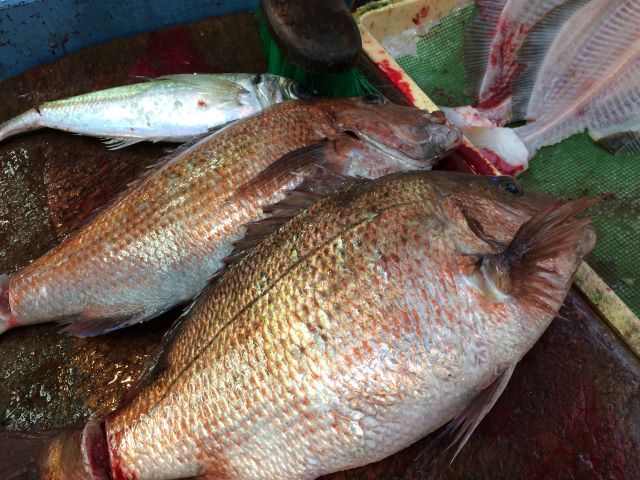
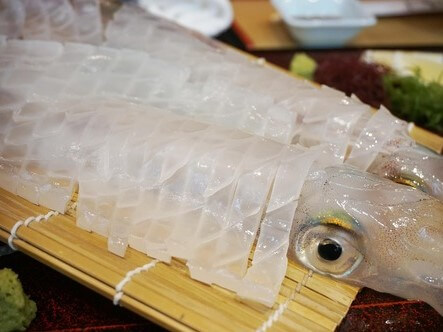 Ikezukuri means to take a fish that’s swimming in a tank at the restaurant, and immediately making sashimi after killing it, while the meat is still super fresh. In this state, there is no Inosinic acid, but there is quite a show with movement still in the fish and this preparation method gives the best-tasting texture.
Ikezukuri means to take a fish that’s swimming in a tank at the restaurant, and immediately making sashimi after killing it, while the meat is still super fresh. In this state, there is no Inosinic acid, but there is quite a show with movement still in the fish and this preparation method gives the best-tasting texture.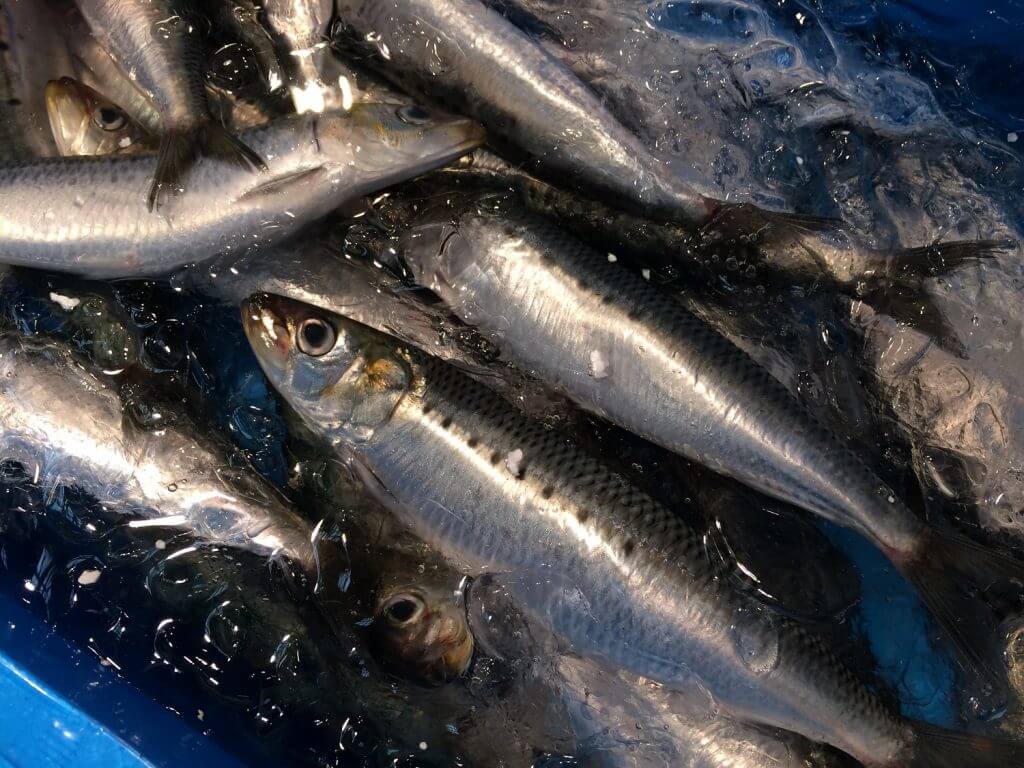 Nojime* means using a massive amount of ice to suddenly reduce the temperature, resulting in the death of the fish, either at the fishing site or at the local market. This method is used for small, cheaper mass-market fish that are caught in large amounts. Nojime starts with a reverse calculation for flavor from the day after fishing, but if the process isn’t thorough or there are any deficiencies, the fish won’t stay as fresh, so detailed care must be taken in temperature management.
Nojime* means using a massive amount of ice to suddenly reduce the temperature, resulting in the death of the fish, either at the fishing site or at the local market. This method is used for small, cheaper mass-market fish that are caught in large amounts. Nojime starts with a reverse calculation for flavor from the day after fishing, but if the process isn’t thorough or there are any deficiencies, the fish won’t stay as fresh, so detailed care must be taken in temperature management.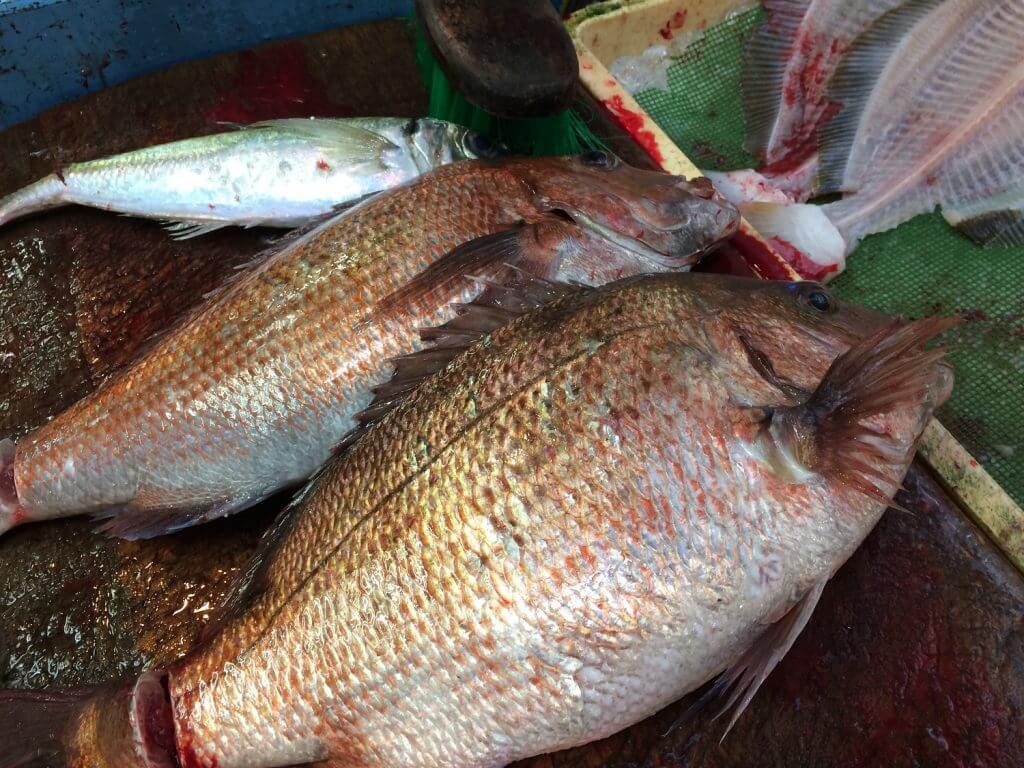 Ikejime is used so that the peak flavor will be reached during afternoon and evening business hours. The spinal cord of the live fish is cut and spinal fluid drained at the early morning market. This result is a firmness from the remaining ATP, and delicious flavor from the Inosinic acid that is generated as time passes. After some time has passed, even fish for which Ikejime is applied, can reach the same state as Hamajime if used after being refrigerated for one to two days, in order to maximize the Inosinic acid generated. Of course, sushi chefs find their own balance of firmness in meat or added flavor, and incorporate this balance for the optimum combination with their shari in each piece of sushi.
Ikejime is used so that the peak flavor will be reached during afternoon and evening business hours. The spinal cord of the live fish is cut and spinal fluid drained at the early morning market. This result is a firmness from the remaining ATP, and delicious flavor from the Inosinic acid that is generated as time passes. After some time has passed, even fish for which Ikejime is applied, can reach the same state as Hamajime if used after being refrigerated for one to two days, in order to maximize the Inosinic acid generated. Of course, sushi chefs find their own balance of firmness in meat or added flavor, and incorporate this balance for the optimum combination with their shari in each piece of sushi.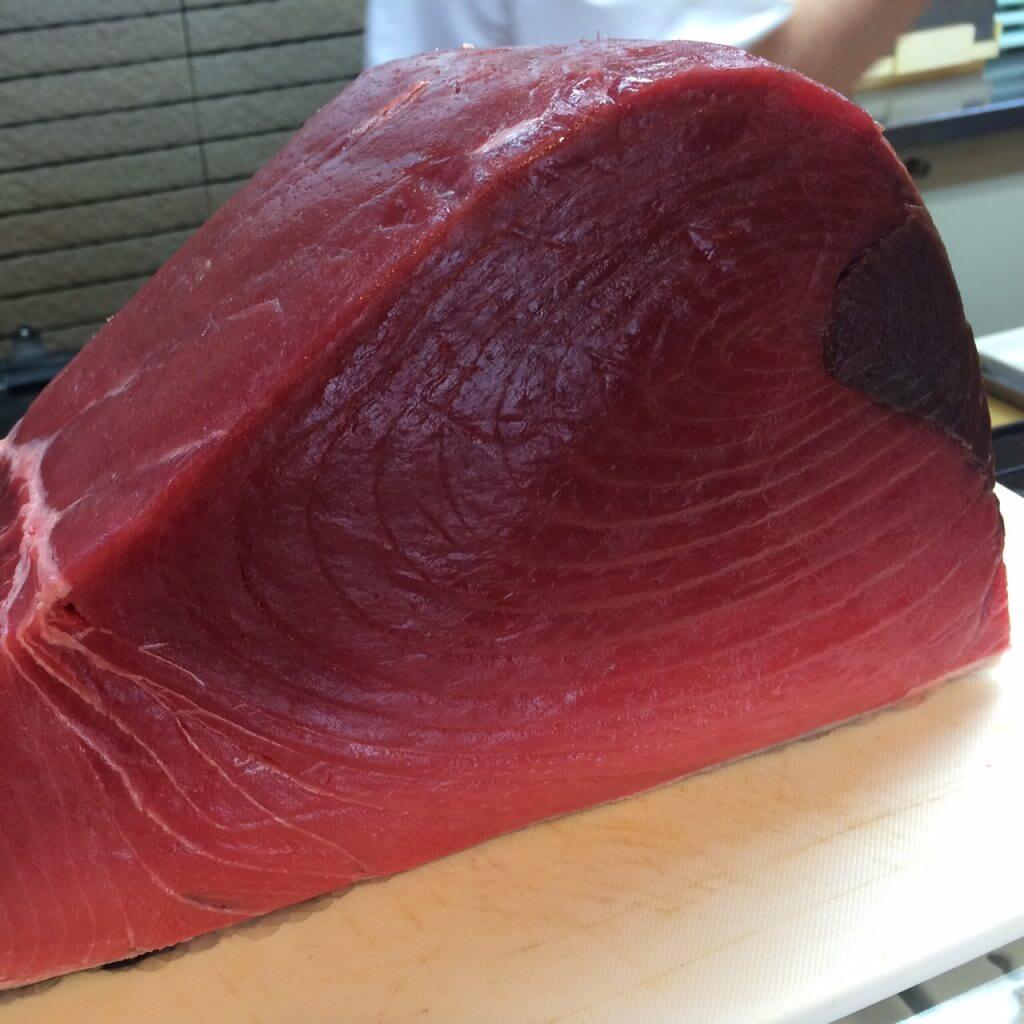 Why is only tuna brought into certain ports high-priced, even though all of the tuna is caught in the seas near Japan? This is because the level of stress caused to the fish when it is caught has a huge impact on the quality, including taste, color and texture. In other words, the same fish may be delicious or taste unpleasant depending on how the fisher handles the fish directly after catching it. Naturally, everyone ends up wanting the fish from the ports with fisherman who are skilled in this practice*. Furthermore, it is individuals who process the fish. The quality changes drastically depending on who caught it.
Why is only tuna brought into certain ports high-priced, even though all of the tuna is caught in the seas near Japan? This is because the level of stress caused to the fish when it is caught has a huge impact on the quality, including taste, color and texture. In other words, the same fish may be delicious or taste unpleasant depending on how the fisher handles the fish directly after catching it. Naturally, everyone ends up wanting the fish from the ports with fisherman who are skilled in this practice*. Furthermore, it is individuals who process the fish. The quality changes drastically depending on who caught it.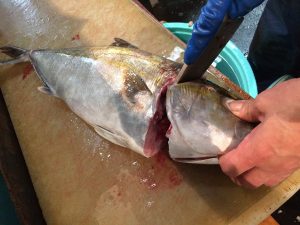 How the fish is butchered also changes the taste. If the fish suffers and struggles, the body wears and may be damaged, circulating oxidized blood throughout the body, which makes it lose flavor. For fish of high value such as sea bream, flounder, yellowtail, rudderfish and tuna, a method called “
How the fish is butchered also changes the taste. If the fish suffers and struggles, the body wears and may be damaged, circulating oxidized blood throughout the body, which makes it lose flavor. For fish of high value such as sea bream, flounder, yellowtail, rudderfish and tuna, a method called “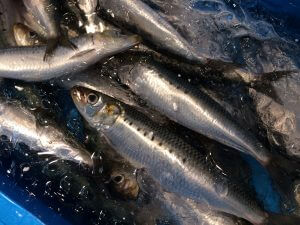 Freezing the fish to death in ice water is called “
Freezing the fish to death in ice water is called “